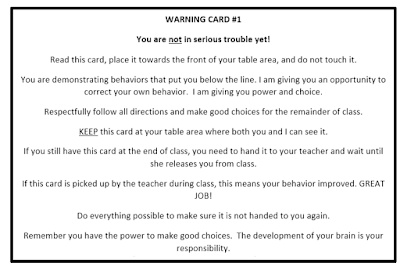Warning Cards – and How to Use Them
Just a little background on this system… First, I am not an advocate of one size fits all teaching. However, I will say that the cards work if you use the script…
Here is my story about these cards and how it failed...
I heard Doug Curry’s training and was all psyched to use the warning cards. I printed them, laminated them and issued them accordingly. And, it failed, it was a big fat failure… kids argued, threw them on the floor, tore them up. So, because failure is not a permanent state of being in my brain… I sought answers and actually read the Llama Book Doug Curry wrote and found the “script”.
I practiced the script and applied… and it worked.
It worked tremendously, it worked so well that I had to giggle a little bit… So, my advice to you is to do the same, train the kids, practice the script (practice with kids in the hall, on your significant other) and apply… the only caveat would be to use PBIS words, like SOAR when redirecting behavior.
Don’t tell me the warning cards don’t work, unless you can tell me you said the script written by Doug verbatim and it failed… It works, I promise. When I was getting August PD together, I emailed Doug and asked for a video of him using the cards… unfortunately, no such video exists… but, Doug did say to share the script with you… so I take that as good advice…
Part I -
Call to Attention: Whatever one you choose to use, but, please, just use one…
Me – “Everyone show me your PLAN” (Put things down, Lean forward, Ask questions, Nod your head).
I’ve used SLANT before, (Sit up, Lean forward, Ask questions, Nod your head, Track the teacher) SLANT works great too.
At my school in Amarillo we used PLAN and I wanted to be consistent and it just stuck.
Me – scan the room for 100% compliance. That means I am really checking.
Part II -
The Cards
Again... TRAIN the kids on the system. Spend time going over the cards system and practice with them. This is the most important step, when I did this, they stopped ruining the cards and the system worked.
When correcting classroom behavior, like excessive talking, or off task, first I will go to the kid, stand in front of them and say, “I need you to sit quietly while working”, “please show me your PLAN, thank you”
If they don’t comply, they get a yellow card, I say, ““I need you to sit quietly while working”, “please show me your PLAN, thank you”
If they don’t comply, they get a pink card, I say, “I need you to sit quietly while working”, “please show me your PLAN, thank you”
Cards are pink and yellow because that is the colors of cardstock I had... nothing more than that...
Notice, that I don’t say anything else…
If they still won’t, then I will beg, I say, “I know you’re a good kid, and I don’t want to write a referral (which means a call home). I will if I need to. But, I don’t want to. There are 15 (or 20 or 5 whatever), minutes left in class. All we need you to do is just sit here quietly and finish assignment (or listen or whatever). I love having you in this class. Can you to do that? Tomorrow is a new day.”
The word "beg" is a real trigger for some teachers, and I can see that, but, it's more about "saying what you mean, and meaning what you say without being mean."
Begging doesn’t make you weak, it makes you nicer, and then makes the kid comply and that makes you a fast llama.
If they argue, say things like, “I wasn’t the only one, or why are you picking on me?”,
I say “shh, shh, just be cool, I am not allowed to argue."
Just wait a minute.
"Sorry, Sorry, the principal says I am not allowed to argue.”
Never ever pick up the rope!
I found tremendous success with using the card system. Remember, you can always..
Adopt it - use the system just as I mentioned above
Adapt it - instead of using the prescribe cards, I have seen teachers use just a sticky note with a private message on it. I created my own cards that mentioned the LINE. Stick to the script though.
Replace it - Find a system that works for you, but, find a system, ignoring bad behavior will not make it go away.
These are Doug's original cards...
These are my adaptation:
References
Curry, D. (2015). How to train a llama: exceptional classroom management. Place of publication not identified: TurnAround Schools Publishing.







No comments:
Post a Comment
Join in the conversation: